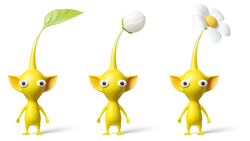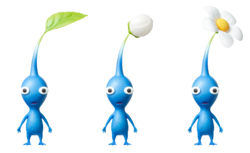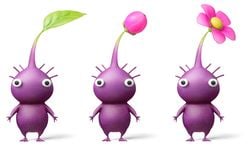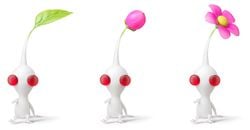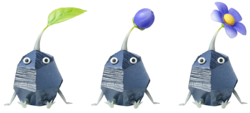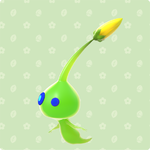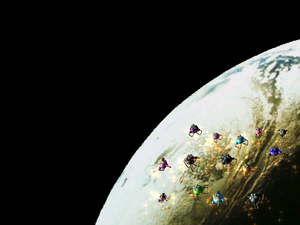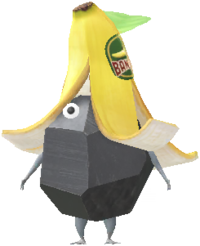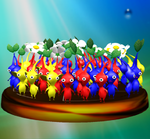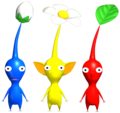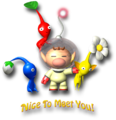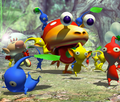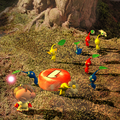Pikmin family: Difference between revisions
CaptainJeffy (talk | contribs) m (→Trivia: Made the Wii System Transfer bit a little more clear.) |
Tag: Mobile edit |
||
| Line 84: | Line 84: | ||
[[File:BudGlowPikmin.png|150px|thumb|A Glow Pikmin in the bud stage.]] | [[File:BudGlowPikmin.png|150px|thumb|A Glow Pikmin in the bud stage.]] | ||
{{main|Glow Pikmin}} | {{main|Glow Pikmin}} | ||
'''Glow Pikmin''' are a special species of Pikmin with green bioluminescent ghost-like bodies, and are present in ''Pikmin 4'' only. They are capable of flying, similar to Winged Pikmin. They only come out at night, and live in burrow-like mounds. Also, if the player has a large amount of Glow Pikmin, then they can form them into a large green energy orb called a Glowmob that can be used to hit enemies. They are produced by bringing star-like objects to their mounds. | '''Glow Pikmin''' are a special species of Pikmin (which in-universe may not be a Pikmin at all, according to the Piklopedia), with green bioluminescent ghost-like bodies, and are present in ''Pikmin 4'' only. They are capable of flying, similar to Winged Pikmin. They only come out at night, and live in burrow-like mounds. Also, if the player has a large amount of Glow Pikmin, then they can form them into a large green energy orb called a Glowmob that can be used to hit enemies. They are produced by bringing star-like objects to their mounds. | ||
{{clear}} | {{clear}} | ||
Revision as of 09:54, July 23, 2023
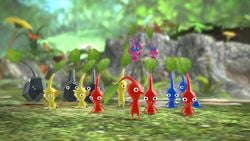
Pikmin (ピクミン?) are plant-animal hybrid creatures that are found on PNF-404 and the planet in Hey! Pikmin. As the titular creatures of the Pikmin series, they are the main feature of gameplay in all games in the series.
In the main games, Pikmin are created by Onions, which produce them as seeds, which in turn fall to the ground and become sprouts. The player can then get a leader to pluck one of these sprouts. Once plucked, Pikmin follow a leader around the area in a squad, and the leader can throw them at objects, as well as dismiss, swarm, and charge them. When out of a leader's squad, they can be whistled back into it. Through these basic actions, Pikmin can be ordered to carry items or fight enemies, among other abilities.
Pikmin come in several types, each with certain unique abilities (such as resistance to a specific hazard). Most are 1.2cm tall head to toe (around 3cm if the stem and top are included), and have a generally humanoid shape. On top of a Pikmin's head is either a leaf, bud, or flower, representing its maturity.
On its own, a Pikmin is not particularly strong, but in large groups (usually up to 100), they are capable of doing many things. However, Pikmin can be eaten by enemies, and if a player loses all Pikmin of a type, a Pikmin extinction can occur. Fortunately, Pikmin can be grown easily by carrying defeated enemies or pellets to the Onion. In addition, Candypop Buds can convert Pikmin from one type to another.
Types
Pikmin come in several different types, each with unique physical attributes and abilities. The differences between Pikmin types is often utilized in puzzles. As the player progresses through a game's story, more types are unlocked, which over time allow the player to access more sections of areas. While the Pikmin types available in each game are different, every game features the original trio of Red Pikmin, Yellow Pikmin, and Blue Pikmin.
Red Pikmin
- Main article: Red Pikmin.
Red Pikmin have pointy noses and white flowers, and are present in all Pikmin games. They are resistant to fire and have a strong attack strength, making them good at combat. They are the first type discovered in all Pikmin games, except Pikmin 3.
Yellow Pikmin
- Main article: Yellow Pikmin.
Yellow Pikmin have large ears and white flowers, and are present in all Pikmin games. They can be thrown higher than other types, but their other unique abilities vary by game. In Pikmin, they are the only type that can carry bomb rocks. In Pikmin 2, Pikmin 3, Pikmin 4 and Hey! Pikmin, they are resistant to electricity (they can also conduct electricity in Pikmin 3 and Hey! Pikmin). In Pikmin 3, they are the first type to be discovered, and can dig faster than most other Pikmin types.
Blue Pikmin
- Main article: Blue Pikmin.
Blue Pikmin have mouths and white flowers, and are present in all Pikmin games. They are resistant to water, making them the only type able to access submerged portions of areas where other Pikmin would drown. They are the last type discovered in all games except Hey! Pikmin and Pikmin Bloom, though thanks to Pikmin 4's mechanics, it is possible to discover them earlier than in previous games.
Purple Pikmin
- Main article: Purple Pikmin.
Purple Pikmin have short hairs, pink flowers, and are bulkier than other Pikmin types. They are present in Pikmin 2, Pikmin 4, Pikmin Bloom, as well as the alternative game modes of Pikmin 3. They weigh 10 times as much as other Pikmin types, are slower than other types, can carry 10 times the weight of other types, and can attack with a strong pound capable of stunning enemies. They are native to caves and do not have an Onion, meaning that they can only be grown by throwing other Pikmin into Candypop Buds.
White Pikmin
- Main article: White Pikmin.
White Pikmin have red eyes and pink flowers, and are present in Pikmin 2, Pikmin 4, Pikmin Bloom, as well as the alternative game modes of Pikmin 3. They are resistant to poison, are faster than other Pikmin types, can poison enemies upon being eaten, and can dig hidden underground treasures other types cannot see. They are native to caves and do not have an Onion, meaning that they can only be grown by throwing other Pikmin into Candypop Buds.
Rock Pikmin
- Main article: Rock Pikmin.
Rock Pikmin are greyish-black, shaped like rocks, and have purple flowers. They are present in Pikmin 3, Pikmin 4, Hey! Pikmin, and Pikmin Bloom. Their hardness allows them to destroy crystal obstacles, attack enemies through a powerful direct impact, and be resistant to being crushed or stabbed.
Winged Pikmin
- Main article: Winged Pikmin.
Winged Pikmin are pink and have wings, blue eyes, and purple flowers. They are present in Pikmin 3, Pikmin 4, Hey! Pikmin, and Pikmin Bloom. They can fly over water and low barriers, allowing them to take shortcuts when carrying, as well as making it harder for enemies to attack them, but their attack strength is lower than other Pikmin types.
Ice Pikmin
|
This article or section is about an upcoming or recently released game. |
- Main article: Ice Pikmin.
Ice Pikmin are cyan with icy bodies similar to Rock Pikmin, albeit with a distinct head, and yellow flowers. They are first introduced in Pikmin 4. Ice Pikmin can freeze enemies by filling up a meter around the enemy's health wheel or by being eaten. The bodies of frozen enemies shatter upon death, leaving a droplet of nectar behind in a manner similar to how ultra-bitter spray functions. They can also be tossed into water to freeze it, allowing leaders and other Pikmin to walk across its surface, at the cost of becoming stuck in the ice.
Bulbmin
- Main article: Bulbmin.
Bulbmin are a special species of Pikmin shaped like a minuscule Bulborb with a stem, and are present in Pikmin 2 only. They are resistant to fire, water, electricity, and poison, but cannot be taken out of caves, which are the only places they are found in. They are actually a parasite that takes over a juvenile Bulborb; the appearance of the parasite on its own is not known.
Glow Pikmin
- Main article: Glow Pikmin.
Glow Pikmin are a special species of Pikmin (which in-universe may not be a Pikmin at all, according to the Piklopedia), with green bioluminescent ghost-like bodies, and are present in Pikmin 4 only. They are capable of flying, similar to Winged Pikmin. They only come out at night, and live in burrow-like mounds. Also, if the player has a large amount of Glow Pikmin, then they can form them into a large green energy orb called a Glowmob that can be used to hit enemies. They are produced by bringing star-like objects to their mounds.
Additional types
The following types are not proper Pikmin types, as they are not distinguished by the games and cannot be controlled by leaders, but are related to Pikmin.
Mushroom Pikmin
- Main article: Mushroom Pikmin.
Mushroom Pikmin are a special state of Pikmin, created when the Puffstool attacks Pikmin with its spores. They are purple and have a mushroom instead of a flower, and are present in Pikmin only. They will attack Captain Olimar, and can be attacked by unaffected Pikmin, even though they will not fight back.
Pikpik carrots
- Main article: Pikpik carrot.
Pikpik carrots are plants from the planet of Hocotate that Pikmin are named after. While they do not appear in gameplay, they can be thrown at enemies in Pikmin 2's Piklopedia and Pikmin 4's Piklopedia. Pikpik carrots exist in the files of Pikmin 2 and Pikmin 3 as a type of Pikmin, but it is not possible to obtain them in gameplay.
Other types
|
Warning: the following text contains major spoilers about the best ending of Pikmin.
|
|---|
In the best ending of Pikmin, there is a scene where a group of fourteen different colored Onions fly above the atmosphere of PNF-404. |
Biology

Pikmin have a generally humanoid body shape. All types have a head with two round eyes, two arms and hands. With the exception of Glow Pikmin, Pikmin also have two legs and two feet. Each hand and foot has three digits. Pikmin heads have a tall stem on which a single leaf, bud, or five-petaled flower grows. There are differences between Pikmin types in ways other than color – Red Pikmin have a nose, Yellow Pikmin have ears, Blue Pikmin have a mouth, Purple Pikmin are wider and have 6 hairs, White Pikmin are smaller and have red eyes, Rock Pikmin are shaped like rocks, and Winged Pikmin have wings and blue eyes.
Their proportions, with a large head and very narrow limbs, make them look a bit like carrots, and this resemblance also exists in the way that Pikmin grow in the ground and can be pulled out of it. While buried in the ground, their limbs serve as roots; Olimar refers to their entire bodies, save the stems, as ambulatory root structures.[1] While all Pikmin of a type are the same size in most games, in Pikmin Bloom, individual Pikmin have slightly different sizes.
Pikmin start their lives as seeds ejected from the Onion, which, after landing in the ground, transform into sprouts. A leader must pluck a sprout so that the Pikmin may come out. While idle, the Pikmin's leaves and flowers glow that Pikmin's respective color; that, coupled with a cutscene at the end of Pikmin 2, would suggest that Pikmin are somehow bioluminescent, though what causes this and what function it might serve in the wild has never been explained.
The internal structures of Pikmin are a mystery, but certain things about them can be speculated. Since Pikmin never seem to eat anything, save nectar, they probably have a very simple digestive system, if any. As such, it is likely that Pikmin get a majority of their nutrients from food the Onions break down. Since the Onions are the center of Pikmin reproduction as well, it seems likely that Pikmin are incapable of sexual reproduction. However, in Pikmin, flower Pikmin will sometimes drop seeds when slain in battle, suggesting that they may be able to reproduce asexually, but also that they do not have defined sexes and are hermaphrodites like many plants. Pikmin also have a skeletal system, as seen when electrocuted. Pikmin probably don't have any sort of lungs (however, the Blue Pikmin are observed to have gill structures), but their leaves, buds, and flowers appear to serve as their main means of respiration, since poison gas or water droplets collecting around them suffocates the Pikmin; inversely, walking in shallow water in which their leaf/bud/flower does not touch (as seen in the Shower Room) is fine. When killed, Pikmin disappear and a soul flies into the air, sometimes after releasing a liquid of the same color as the Pikmin, possibly the Pikmin equivalent to hemolymph or blood – this is best seen when the Cloaking Burrow-nit attacks.
Stages
- Main article: Maturity.
There are 3 stages of life that a Pikmin can be in: leaf, bud, and flower. A Pikmin's maturity controls its walking and carrying speed. Leaf Pikmin are the slowest, flower Pikmin are the fastest, and bud Pikmin are in between. A Pikmin's maturity is not connected to its type.
When an Onion or Candypop Bud sends out a seed, it will always be in the leaf stage. If left in the ground, the leaf will grow into a bud, and then into a flower. Thus, the longer the player waits before plucking the Pikmin, the faster it will be. Pikmin can go instantly to the flower stage by drinking nectar, or being powered up by an ultra-spicy spray in Pikmin 3. They can also decrease in stage in Pikmin, Pikmin 2, and Pikmin 4 through certain enemy attacks.
In Pikmin Bloom, there are several varieties of flowers that Pikmin can have, and petals can also be collected from Pikmin flowers.
Decor Pikmin
- Main article: Decor Pikmin.
Decor Pikmin are a special status of Pikmin in Pikmin Bloom. They differ from regular Pikmin in that they wear some decoration. These decorations are generally made from objects like flower heads, acorns, or cupcakes, but there are some Decor Pikmin that have more elaborate costumes. Different types of Decor Pikmin are collected by finding Pikmin seedlings in specific types of real-world locations. There are over 30 sets of costumes, and over 200 types of Decor Pikmin.
Habits
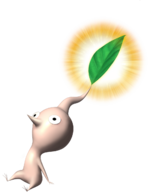
When a Pikmin is in a leader's squad, it will follow that leader in a large group with other Pikmin, waiting still when the leader stands still, and running after the leader when the leader runs, going around small obstructions if possible. They can trip or stumble, however, and this can lead them to be separated from the group. The probability of tripping and stumbling varies by game.
In combat, a Pikmin latches onto the enemy and repeatedly pummels it using its stalk. The sole exception to this is the Rock Pikmin, which is normally unable to latch onto enemies and instead repeatedly charges at the enemy.
When a Pikmin is not in a leader's squad and is not doing a task, it is idle. Idle Pikmin have various animations they do, such as sitting down and standing up, grooming each other, communicating in high pitched whimpers, waving, and playing abstract games. In Pikmin 2, if 20 of each type of Pikmin is called into one group, they will hum a portion of the song Ai no Uta. This suggests that they have a highly developed and friendly social structure. Pikmin will also watch leaders move around when stationary, indicating that they are very curious creatures, and can be seen to mimic the idle motions of those leaders. If there is a task nearby that an idle Pikmin can do, such as attacking an enemy, it will run to the task and do it.
In Pikmin, if Pikmin are told to go in an Onion, they will follow a path to go there if they cannot make it in a straight line.[2] This behavior is rarely seen, given that the area layouts seldom allow Pikmin to be unable to enter the Onion from a straight walk while also being under the control of a leader that is close enough to the Onion's beam. This does not happen in Pikmin 2 or Pikmin 3, as Pikmin will always run in a straight line towards the Onion, except when the Assemble All feature is used.
In Pikmin 3, having a group of 66 or less Pikmin of any type and moving the cursor around the Pikmin or around the group will make some Pikmin look at the cursor, although this may just be aesthetic. For Winged Pikmin, this only works if they are walking. Interestingly, leaders do not display this behavior.
In Pikmin 3 Deluxe, Pikmin that are told to deliver something to the Onion memorize which player ordered them. If the same player is near the Onion when they finish delivery, they will return to that player's group. If that player isn't nearby, but the other player is, the Pikmin will ignore them and go idle.
Naming
During the development of Pikmin, Pikmin were referred to as "Piki" (ピキ?), and later "Picky" (ピッキー?), due to a programmer mishearing the word 一匹? (lit.: "one small animal"). The final name was chosen for its similarity to the words "pick me".[3][4]
The early name "Piki" is still used as part of the Honeywisp's common name of ピキマキ? (lit.: "Pikmin Aphid"), as well as sometimes being used inside the game's files, such as the term "piki park" in animtest, and the folder /dataDir/pikis in Pikmin's file structure. Likewise, they are sometimes referred to as "pikumin" or "piku", like in Hey! Pikmin's internal names for the Coppeller that carries Pikmin (enemy_carry_piku).
The in-universe reason for the name is that Captain Olimar named the Pikmin after a type of vegetable from Hocotate, the pikpik carrot. The plural of Pikmin is also "Pikmin", and the word is typically never written with a lowercase "P", except for the US Spanish localizations of Pikmin 3, Hey! Pikmin, and Pikmin 3 Deluxe, as well as in unused pieces of text in Pikmin, and all Spanish localizations of Pikmin 2 and New Play Control! Pikmin 2.
Interestingly, some parts of some games do not capitalize the word that defines the type of Pikmin, but capitalize the word "Pikmin" itself, whereas others might capitalize both words. For instance, Olimar's voyage log may write "red Pikmin",[5] while Alph and Brittany's dialogues might have the text "Red Pikmin".[6] In earlier versions of Pikmin, a Pikmin would be referred to as a "pikmin", with a lowercase "p", and the plural would be several "pikmins".[7]
The scientific names for Pikmin (aside from Bulbmin) went unspecified until the Piklopedia from Pikmin 4, where they were all classified under the genus pikminidae, a very straight-forward reference to the family itself.
Names in other languages
| Language | Name | Meaning | Notes |
|---|---|---|---|
| ピクミン? Pikumin |
Pikmin | ||
(traditional) |
皮克敏 Píkèmǐn |
Pikmin | |
(simplified) |
皮克敏 Píkèmǐn |
Pikmin | |
| Pikmin | - | ||
| Pikmin | - | ||
| Pikmin | - | ||
| Pikmin | - | ||
| 피크민 pikeumin |
Pikmin | ||
| Pikmin | - | ||
| Pikmin | - | ||
| Пикмин Pikmin |
Pikmin | ||
| פיקמין pikmin |
Pikmin | Used in official media |
In the Super Smash Bros. series
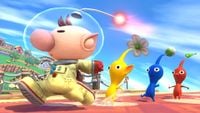
Pikmin form a part of Olimar's moveset in all Super Smash Bros. games Olimar appears in as a playable character. Olimar can pluck Pikmin from the ground and throw them at opponents, which the Pikmin then attack. Red Pikmin, Yellow Pikmin, Blue Pikmin, Purple Pikmin, and White Pikmin are all usable in this way, with slightly different attributes based on their abilities in the Pikmin games. Winged Pikmin are also used in Olimar's up special move in Super Smash Bros. for Nintendo 3DS and Wii U and Super Smash Bros. Ultimate. There are also trophies, stickers, and spirits based on Pikmin.
In Super Smash Bros. Melee, Olimar is not a playable character, but Pikmin appear as a trophy.
Gallery
- Pikmin
Pikmin fighting a Spotty Bulborb.
Pikmin climbing on some horsetails.
Early screenshot showing a multitude of Pikmin.
- Pikmin 2
- Pikmin 2 promo lily pad.jpeg
Wallpaper of a Pikmin of each type on a lily pad.
Pikmin greeting the player in the Pikmin 2 loading screen.
- Pikmin 3
Promotional art of Alph leading the Pikmin away from a Bulborb.
- Pikmin 4
- Hey! Pikmin
- Super Smash Bros. series
Olimar, Alph, and every Pikmin variety (excluding Rock Pikmin) in Super Smash Bros. for Wii U.
- See more: Pikmin images category.
Trivia
- Winged Pikmin have dark stripes on their bodies which make them resemble bees. This color pattern makes their bodies non-monochromatic, a trait uncommon in most Pikmin types. White Pikmin also seem to have this trait to a certain extent, as they exhibit a purplish tint at the ends of their limbs.
- In early versions of Pikmin, Red Pikmin and Blue Pikmin were able to hold bomb-rocks along with Yellow Pikmin. This idea was later scrapped, most likely due to Yellow Pikmin not having use of their high throw ability often, but it was later made a feature of Pikmin 3.
- The first five members of the Pikmin family (from Pikmin to Pikmin 2, not including Bulbmin) appear in the Wii to Wii U data transfer app, in which they "carry" the software and save data from the Wii to the SD card, then to the Wii U console.
- Pikmin resemble a legend about the mandrake plant, a plant whose roots can sometimes resemble a human body. The legend says that if one uproots a mandrake plant, it will be their servant. However, it is also said that if picked, it will emit a scream powerful enough to kill its picker, so it was recommended to form a strategy for picking it, like tying it to a dog.
- Each of the main 5 Pikmin in Pikmin 2 represent the 5 common senses:
- Smell: Red Pikmin have prominent noses.
- Taste: Blue Pikmin have visible mouths, unlike the others.
- Hearing: Yellow Pikmin have prominent ears.
- Touch: Purple Pikmin have feeler-like hairs atop their head.
- Sight: White Pikmin have absurdly large eyes.
- In addition to this, each of the main 5 Pikmin in Pikmin 3 seem to correspond with the classical elements:
- Fire: Red Pikmin
- Water: Blue Pikmin
- Earth: Rock Pikmin
- Air: Winged Pikmin
- Aether: Yellow Pikmin
- In Pikmin 3, Rock Pikmin, Winged Pikmin, and Yellow Pikmin have their own voice, different from the other types of Pikmin. In Pikmin 2, Purple and White Pikmin have their own voice during their introduction cutscene. However, they have the same voice as other Pikmin types during normal gameplay.
- In the Pikmin Short Movies, Purple Pikmin have a deeper voice than the other types, as seen in the Treasure in a Bottle scene where three Blue Pikmin and one Purple Pikmin chase after a butterfly.
- Despite their flowers being indigo in-game, the flowers of Winged Pikmin and Rock Pikmin are blue in some early concept art.
- The Pikmin appear in some games and media outside of the franchise as cameos.
- For an unknown reason, in Pikmin 2, it is impossible to have 100 Pikmin buried in the same area or sublevel, if the Pikmin in question were buried by an enemy. The last Pikmin will simply get knocked back (in the case of a Mamuta)[8] or stay idle (in the case of a Swooping Snitchbug)[9]. Attempting to get 100 seeds via delivering items to an Onion is possible, though.
- The Pikmin types that are better at combat are found before any other types in each of the mainline games. In Pikmin, these are the Red Pikmin, in Pikmin 2, these are Red Pikmin and Purple Pikmin, and in Pikmin 3, these are Red Pikmin and Rock Pikmin.
- Pikmin noises are created by recording a human making a sound, speeding it up, and raising the pitch+formant values. Most types of Pikmin are voiced by Hajime Wakai.[10][11]
- If a leader bumps against a Pikmin that is bringing something solo in Pikmin 3, it will make some noise.
See also
References
- ^ “Like Pikmin, the creeping chrysanthemum is a member of a group of creatures with ambulatory root structures. This creature is known as a "mimic," but because it is actually a form of plant, this label is not entirely accurate. For unknown reasons, the creeping chrysanthemum's mimicry does not fool Pikmin, perhaps because they share a similar heritage. It relies on preying upon other creatures to provide sustenance, so it has no need of leaves for photosynthesis. Generally speaking, the role of plants within an ecosystem is as a producer species, and thus plants are generally found at the bottom of the food pyramid. However, on this strange planet the line between producer plants and consumer plants is blurred.” – Captain Olimar in his notes for the Creeping Chrysanthemum
- ^ YouTube video showing the Pikmin following a path in order to enter the Onion
- ^ Ask the Developer Vol. 10, Pikmin 4—Part 1 on Nintendo Official Site, retrieved on July 20th, 2023
- ^ Ask the Developer: Pikmin 4 on Nintendo of Japan, retrieved on July 20th, 2023
- ^ “Fire should be a natural enemy of the Pikmin, but on closer examination, I've found red Pikmin to be impervious to it. It is fascinating. The reds continue through the flames, completely oblivious to any Pikmin burning around them...” – Captain Olimar in his voyage log for the fire hazard
- ^ “Come to think of it, Alph, you've been with the Red Pikmin since crash-landing here, right?” – Brittany in a dialog with Alph about Red Pikmin, in the European region of Pikmin 3
- ^ E3 2001 Tech Demo Show Off
- ^ YouTube video showing it is impossible for a Mamuta to bury more than 99 Pikmin
- ^ YouTube video showing it is impossible for a Swooping Snitchbug to bury more than 99 Pikmin
- ^ Pikmin 2 developer interview on Nintendo of Japan, retrieved on April 6th, 2018
- ^ Hajime Wakai on Behind the Voice Actors, retrieved on April 6th, 2018
| Pikmin | |
|---|---|
| Types | Red Pikmin • Yellow Pikmin • Blue Pikmin • Purple Pikmin • White Pikmin Rock Pikmin • Winged Pikmin • Ice Pikmin • Bulbmin • Glow Pikmin |
| Biology | Candypop Bud • Idle • Maturity • Onion • Flarlic • Pellet Pikmin extinction • Trip • Sprout • Seedling • Soul • Squad |
| Abilities | Carry • Dig • Dodge • Fight • Hide |
| Controls | Charge • Dismiss • Swarm • Pluck • Throw • Whistle |
| Other | Decor Pikmin • Leafling • Mushroom Pikmin • Pikpik carrot |
| Characters | |
|---|---|
| Leaders | Captain Olimar • Louie • The President • Alph • Brittany • Charlie • Pikmin 4 player character |
| Rescue Corps | Oatchi • Collin • Shepherd • Russ • Dingo • Yonny • Bernard |
| Ships | S.S. Dolphin • Hocotate ship • S.S. Drake • S.S. Dolphin II • SPERO • S.S. Beagle • S.S. Shepherd |
| Other | Castaway • Leafling • Minor characters • Moss • Pikmin |


